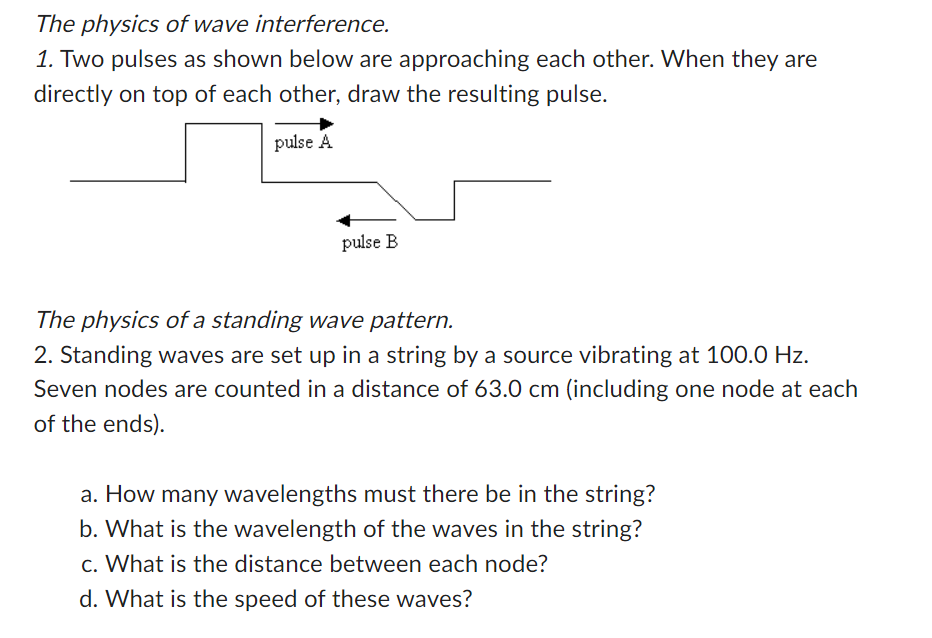The physics of wave interference. 1. Two pulses as shown below are approaching each other. When they are directly on top of each other, draw the resulting pulse. pulse A pulse B The physics of a standing wave pattern. 2. Standing waves are set up in a string by a source vibrating at 100.0 Hz. Seven nodes are counted in a distance of 63.0 cm (including one node at each of the ends). a. How many wavelengths must there be in the string? b. What is the wavelength of the waves in the string? c. What is the distance between each node? d. What is the speed of these waves?
The physics of wave interference. 1. Two pulses as shown below are approaching each other. When they are directly on top of each other, draw the resulting pulse. pulse A pulse B The physics of a standing wave pattern. 2. Standing waves are set up in a string by a source vibrating at 100.0 Hz. Seven nodes are counted in a distance of 63.0 cm (including one node at each of the ends). a. How many wavelengths must there be in the string? b. What is the wavelength of the waves in the string? c. What is the distance between each node? d. What is the speed of these waves?
College Physics
10th Edition
ISBN:9781285737027
Author:Raymond A. Serway, Chris Vuille
Publisher:Raymond A. Serway, Chris Vuille
Chapter14: Sound
Section: Chapter Questions
Problem 7CQ: You are driving toward the base of a cliff and you honk your horn. (a) Is there a Doppler shift of...
Related questions
Question

Transcribed Image Text:The physics of wave interference.
1. Two pulses as shown below are approaching each other. When they are
directly on top of each other, draw the resulting pulse.
pulse A
pulse B
The physics of a standing wave pattern.
2. Standing waves are set up in a string by a source vibrating at 100.0 Hz.
Seven nodes are counted in a distance of 63.0 cm (including one node at each
of the ends).
a. How many wavelengths must there be in the string?
b. What is the wavelength of the waves in the string?
c. What is the distance between each node?
d. What is the speed of these waves?
Expert Solution
This question has been solved!
Explore an expertly crafted, step-by-step solution for a thorough understanding of key concepts.
This is a popular solution!
Trending now
This is a popular solution!
Step by step
Solved in 3 steps with 1 images

Knowledge Booster
Learn more about
Need a deep-dive on the concept behind this application? Look no further. Learn more about this topic, physics and related others by exploring similar questions and additional content below.Recommended textbooks for you

College Physics
Physics
ISBN:
9781285737027
Author:
Raymond A. Serway, Chris Vuille
Publisher:
Cengage Learning

Physics for Scientists and Engineers
Physics
ISBN:
9781337553278
Author:
Raymond A. Serway, John W. Jewett
Publisher:
Cengage Learning

Physics for Scientists and Engineers with Modern …
Physics
ISBN:
9781337553292
Author:
Raymond A. Serway, John W. Jewett
Publisher:
Cengage Learning

College Physics
Physics
ISBN:
9781285737027
Author:
Raymond A. Serway, Chris Vuille
Publisher:
Cengage Learning

Physics for Scientists and Engineers
Physics
ISBN:
9781337553278
Author:
Raymond A. Serway, John W. Jewett
Publisher:
Cengage Learning

Physics for Scientists and Engineers with Modern …
Physics
ISBN:
9781337553292
Author:
Raymond A. Serway, John W. Jewett
Publisher:
Cengage Learning


College Physics
Physics
ISBN:
9781938168000
Author:
Paul Peter Urone, Roger Hinrichs
Publisher:
OpenStax College

University Physics Volume 1
Physics
ISBN:
9781938168277
Author:
William Moebs, Samuel J. Ling, Jeff Sanny
Publisher:
OpenStax - Rice University